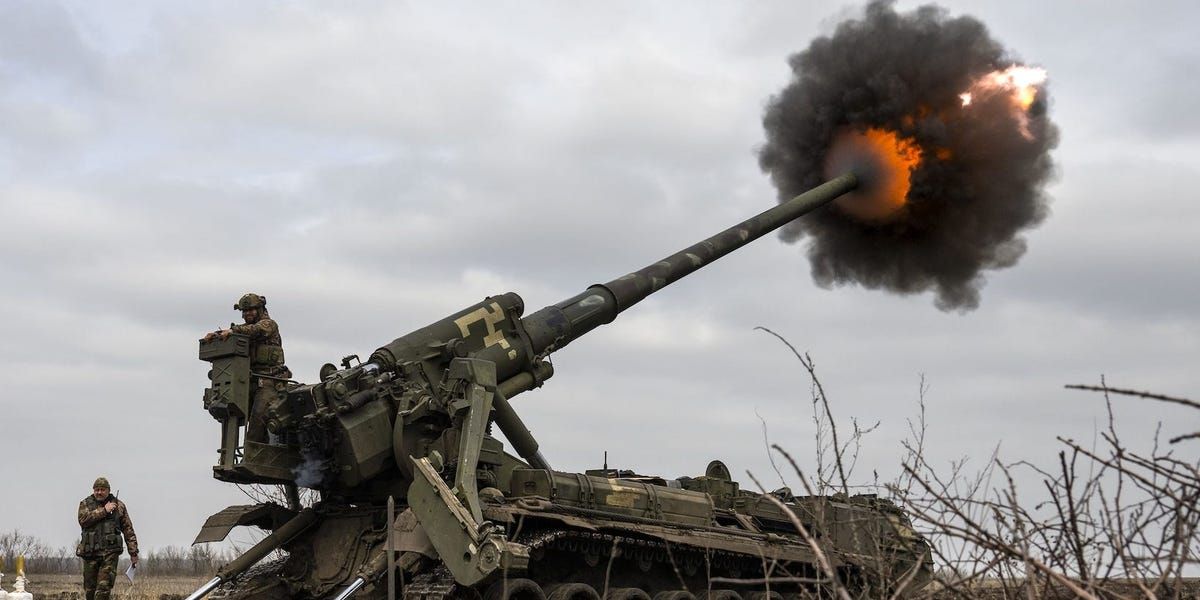Ukrainian Artillery Uses Drones, Google Maps to Find Russian Targets
In the days after Russia's invasion last year, Ukrainian forces need help targeting Russian troops.
One Ukrainian artillery unit relied on help from Ukrainian civilians to guide their strikes.
Using repurposed drones, cameras and phones, and Google Maps, that unit put rounds on its targets.
Top editors give you the stories you want — delivered right to your inbox each weekday. Loading Something is loading. Thanks for signing up! Access your favorite topics in a personalized feed while you're on the go. download the app Email address By clicking ‘Sign up’, you agree to receive marketing emails from Insider as well as other partner offers and accept our Terms of Service and Privacy Policy
Hobby drones and Google Maps were designed to enhance human life, not to end it, but when Russian tank columns seemed to be closing in on Kyiv in the days after Russia's attack on February 24, 2022, desperate Ukrainian defenders found they had two unlikely assets.
Col. Oleh Shevchuk, commander of Ukraine's 43rd Artillery Brigade, and Col. Serhiy Ogerenko, the brigade's chief of staff, told Ukrainian media that they were able to use civilian drones and Google Maps, sometimes with the help of Ukrainian civilians, to locate and target Russian forces in the early days of the war.
At the time, Ukrainian gunners faced the problem of hitting Russian vehicles — moving targets — without trained forward observers to estimate where the vehicle would be when the shell landed.
"That's why we needed 'eyes,'" Ogerenko said. "We called civilians and asked, 'Do you see this section of the road? If a shell hits in a minute and a half, can you tell us at least roughly where it exploded?' Then the person would describe the place of the explosion, and we would open a Google map and see, yes, there is such a place behind the vegetable gardens."
A woman uses her smartphone in a house damaged by shelling in southeastern Kyiv in March 2022. GENYA SAVILOV/AFP via Getty Images
Civilians also offered to use their hobby drones as scouts and artillery spotters. DJI Mavic quadcopters — nicknamed "wedding drones" because that is what they were used to record before the war — proved invaluable to the 43rd Artillery Brigade.
"They provided the picture," Shevchuk said, according to a translation of the interview. "4G, WhatsApp, a video call — the cameraman picked up, saw something, took off his phone, and said, 'look what I have.' I looked at it and said, 'hold it. We're going to shoot now.' It was convenient."
Drones — both military-designed and civilian models — are among the most vital assets for troops on both sides of the war. Ukrainian and Russian drones prowl the skies constantly, looking for enemy positions and movements, as well as for artillery batteries, supply depots, and command posts.
Shevchuk recounted how "one guy from a gas station even gave us access to his camera." Rather than explain the situation to Ukrainian gunners, the owner told them, "'here's the password. See for yourself,'" Shevchuk recalled. "That's how we saw our first live target — a column of Chechens near Novyi Bykiv [37 miles from Kyiv] heading towards Kyiv. So we 'met' them three kilometers [1.9 miles] further."
A drone operator corrects Ukrainian 82mm mortar fire toward Russian positions in the Donetsk region in April. SERGEY SHESTAK/AFP via Getty Images
Sometimes Ukrainian forces would get indications that Russian troops were in a village, but not their precise location. "We open a Google map, see a store, see its phone number, and dial it," said Shevchuk, who described a typical conversation:
"Good evening, we are from Ukraine! Do you have any Katsaps [Ukrainian slur for Russians] in the village?" "Yes." "Where?" "Behind Grandma Hanna's house." "What house does Grandma Hanna have?" "Well, everyone knows her!"
"So you talk to people a little bit and realize where everything is," Shevchuk added.
This isn't the only example of how Ukrainian civil society is using consumer technology to enhance Ukraine's military capabilities. To cope with waves of Russian long-range drones penetrating deep into Ukrainian territory, the Ukrainian military has formed mobile air-defense teams equipped with short-range anti-aircraft weapons.
Ordinary citizens can use cellphone apps to report drone sightings to a central database, which can then alert mobile air-defense units.
Ukrainian troops fire an 2S7 Pion howitzer at Russian positions near Bakhmut in March. Muhammed Enes Yildirim/Anadolu Agency via Getty Images
Ukrainians using video cameras and cellphones to call in artillery fire on Russians forces as they pass by is a bizarre, almost comical, illustration of how a modern war can play out in an urban environment. But it also shows how much danger those civilians faced from invaders intent on defeating Ukraine's military and then repressing the Ukrainian public.
Russian troops and Wagner Group mercenaries have been accused of numerous atrocities against Ukrainian civilians, and Moscow has clamped down on Ukrainians living in areas it still controls in an effort to prevent attacks by partisans or special-operations forces. Anyone suspected of providing intelligence to Ukraine's devastatingly effective artillery could expect little mercy.
"We lost contact with many people, and some said: 'That's it, I'm turning off my phone, deleting all my contacts. There are Russians in the next house,'" Shevchuk said of civilians his forces were in contact with. "Some people immediately said: 'I'm scared, don't ask me any questions.' But people called us from everywhere."
Michael Peck is a defense writer whose work has appeared in Forbes, Defense News, Foreign Policy magazine, and other publications. He holds a master's in political science. Follow him on Twitter and LinkedIn.
Source: Business Insider


